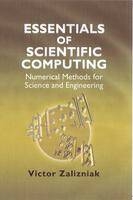
Essentials of Scientific Computing
Horwood Publishing Ltd (Verlag)
978-1-904275-32-9 (ISBN)
- Keine Verlagsinformationen verfügbar
- Artikel merken
Modern development of science and technology is based to a large degree on computer modelling. To understand the principles and techniques of computer modelling, students should first get a strong background in classical numerical methods, which are the subject of this book. This text is intended for use in a numerical methods course for engineering and science students, but will also be useful as a handbook on numerical techniques for research students.
Essentials of Scientific Computing is as self-contained as possible and considers a variety of methods for each type of problem discussed. It covers the basic ideas of numerical techniques, including iterative process, extrapolation and matrix factorization, and practical implementation of the methods shown is explained through numerous examples. An introduction to MATLAB is included, together with a brief overview of modern software widely used in scientific computations.
Dr. Victor Zalizniak was awarded his Masters in Physics at Krasnoyarsk State University, Russia before becoming a Research Fellow at the Centre for Scientific Computing at the Russian Academy of Sciences (Siberian Branch). He then moved to the Department of Aerospace Engineering at the Royal Melbourne Institute of Technology where he obtained his PhD. In 2001 he returned to the Department of Computer Science at his alma mater, Krasnoyarsk State University, where he continues to lecture, research and write in his particular fields of computational physics and mathematical physics. He is the author of several books on scientific computing including Essentials of Computational Physics Parts 1 and 2.
About the Author
Dedication
List of Examples
Preface
1: Errors in computer arithmetic operations
2: Solving equations of the form f(x)=0
2.1 THE BISECTION METHOD
2.2 CALCULATION OF ROOTS WITH THE USE OF ITERATIVE FUNCTIONS
2.3 CONCLUDING REMARKS
3: Solving systems of linear equations
3.1 LINEAR ALGEBRA BACKGROUND
3.2 SYSTEMS OF LINEAR EQUATIONS
3.3 TYPES OF MATRICES THAT ARISE FROM APPLICATIONS AND ANALYSIS
3.4 ERROR SOURCES
3.5 CONDITION NUMBER
3.6 DIRECT METHODS
3.7 ITERATIVE METHODS
3.8 COMPARATIVE EFFICACY OF DIRECT AND ITERATIVE METHODS
4: Computational eigenvalue problems
4.1 BASIC FACTS CONCERNING EIGENVALUE PROBLEMS
4.2 LOCALIZATION OF EIGENVALUES
4.3 POWER METHOD
4.4 INVERSE ITERATION
4.5 ITERATION WITH A SHIFT OF ORIGIN
4.6 THE QR METHOD
4.7 CONCLUDING REMARKS
5: Solving systems of nonlinear equations
5.1 FIXED-POINT ITERATION
5.2 NEWTON’S METHOD
5.3 METHOD WITH CUBIC CONVERGENCE
5.4 MODIFICATION OF NEWTON’S METHOD
5.5 MAKING THE NEWTON-BASED TECHNIQUES MORE RELIABLE
6: Numerical integration
6.1 SIMPLE QUADRATURE FORMULAE
6.2 COMPUTATION OF INTEGRALS WITH PRESCRIBED ACCURACY
6.3 INTEGRATION FORMULAE OF GAUSSIAN TYPE
6.4 DEALING WITH IMPROPER INTEGRALS
6.5 MULTIDIMENSIONAL INTEGRATION
7: Introduction to finite difference schemes for ordinary differential equations
7.1 ELEMENTARY EXAMPLE OF A FINITE DIFFERENCE SCHEME
7.2 APPROXIMATION AND STABILITY
7.3 NUMERICAL SOLUTION OF INITIAL VALUE PROBLEMS
7.4 NUMERICAL SOLUTION OF BOUNDARY VALUE PROBLEMS
7.5 ERROR ESTIMATION AND CONTROL
8: Interpolation and Approximation
8.1 INTERPOLATION
8.2 APPROXIMATION OF FUNCTIONS AND DATA REPRESENTATION
9: Programming in MATLAB
9.1 NUMBERS, VARIABLES AND SPECIAL CHARACTERS
9.2 ARITHMETIC AND LOGICAL EXPRESSIONS
9.3 CONDITIONAL EXECUTION
9.4 LOOPS
9.5 ARRAYS
9.6 FUNCTIONS
9.7 INPUT AND OUTPUT
9.8 VISUALIZATION
A: Integration formulae of Gaussian type
B: Transformations of integration domains
C: Stability regions for Runge-Kutta and Adams schemes
D: A brief survey of available software
LAPACK library for problems in numerical linear algebra
IMSL mathematics and statistics libraries
Numerical Algorithms Group (NAG) numerical libraries
Bibliography
Index
| Erscheint lt. Verlag | 1.3.2008 |
|---|---|
| Sprache | englisch |
| Gewicht | 330 g |
| Themenwelt | Mathematik / Informatik ► Informatik ► Theorie / Studium |
| Naturwissenschaften | |
| ISBN-10 | 1-904275-32-X / 190427532X |
| ISBN-13 | 978-1-904275-32-9 / 9781904275329 |
| Zustand | Neuware |
| Haben Sie eine Frage zum Produkt? |
aus dem Bereich


